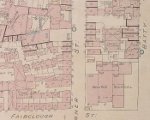 § Berner Street: 1871, disused by the 1920s; now the site of Bernhard Baron House
[street renamed Henriques Street 1961] - Harry Gosling School was built opposite in 1909 - the site of both schools is shown on Goad's 1899 insurance map, right. Here
is a paper on 'Scientific Method in Board Schools' delivered in the
school in 1895. In July 1892 Mrs Louisa Hopkins, chair of a Massachusetts commission
appointed to investigate manual training and industrial education,
visited this, among many other, schools. Note her comments on the
implications of being a Jewish-majority school: § Berner Street: 1871, disused by the 1920s; now the site of Bernhard Baron House
[street renamed Henriques Street 1961] - Harry Gosling School was built opposite in 1909 - the site of both schools is shown on Goad's 1899 insurance map, right. Here
is a paper on 'Scientific Method in Board Schools' delivered in the
school in 1895. In July 1892 Mrs Louisa Hopkins, chair of a Massachusetts commission
appointed to investigate manual training and industrial education,
visited this, among many other, schools. Note her comments on the
implications of being a Jewish-majority school:
...We first called at the St. [sic]
Berner Street Board School, on the spot where the opium joint described
in 'Edwin Drood' stood [she seems to be confusing this with the other
local school she visited, St George's Street].
We visited first the old school building, which was an old rice mill;
the tall mill still stood there; the ground floor is now used as a
storeroom. I saw a cart loading up with apparatus for drawing tables
and large T-squares. We went up stairs and visited the cookery class of
Jewish girls; the teacher was giving a demonstration lesson on a fruit
pie; only a gas stove was in use. After this part of the lesson, which
took one hour, the class was divided, one-half attending the
demonstration lesson and the other half writing it for an hour, and the
next hour vice versa ; the lesson was three hours long, — each child
has sixty lessons. The girls are eleven and twelve years old. The
laundry room we next visited was large, with closets, boiler, tubs,
ironing tables and stove with flat irons. A similar class to the
cooking class was receiving a lesson from the black-board in washing
cretonnes and colored cloths. After this I saw the girls washing at the
tubs, one tub being fltted for washing colored articles, and the other
for white silk scarfs or handkerchiefs which the girls had brought from
home. I saw some of their laundered work also, cuffs and collars, —
very good; the girls evidently enjoyed the work very much.
We then went to the new school-house near by, — Berner Street School.
It was a fine large building, with well-lighted rooms, sliding
partitions largely of glass, big halls and play-grounds for boys on the
top of the building. We visited a sloyd class [a handicaraft-based education system originating in Finland, popular in the USA at this time] taught
by the son of the head master; it showed very good work for the first
year, — in operation only since the previous October. They used knife,
plane, saw, etc....
The pupils of the school are nearly all Jews, Russian or Polish, some
German, who the master said were much the most intelligent. All have to
be taught the English language, and much the same means are used as in
the Eliot School, — in fact, when I described that way, the master said
it was exactly his way, and he thought he had invented it. However, I
saw the boys spelling small words on the black-board in an
old-fashioned way, without knowing what they meant or how to use them ;
then they learn to use a book and write words, and up in the higher
grade to read fairly well. This was not in accordance with the method
described.
All through the school were pictures, cabinets of science objects,
collected by pupils and teachers with some help from a school fund. One
teacher showed me her schedule of object lessons, — much like ours in
the lower grades. Sewing is part of the girls' work. The boys come for
extra time in sloyd. The
master complained that as soon as the boys got up a little way many
left to go to a Jewish school which gave them some advantages and was
privately endowed, or else they went to America. Some of the teachers
were Jewish; the teacher of the upper class was selected in order to
conduct their religious exercises suitably. The cookery classes also
have special provision for meeting the Jewish code with regard to food.
|
|
Blakesley
Street
[between Watney Street and Sutton Street, south of Commercial
Road]: serving the most concentrated area of poverty (apart from
St George's Street School), and
becoming predominantly Jewish: a 1910 inspection noted the difficulties attending instruction with a large foreign intake, but reported praiseworthy regularity in attendance and
full interest in work. See here for memories of a Blakesley Street resident. The site is now occupied by Fitzgerald House, a care home for the elderly; see below for the replacement school.
|
 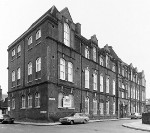 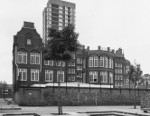 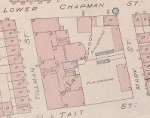 Lower Chapman Street [now Bigland Street] - [left on Goad's 1899 insurance map; right, from front and rear, and today]: one
of Robson's earliest (built 1874-75, with additions by Bailey 1885-86), and one of the few of his to survive (with an
example of a double staircase separating boys from girls). Robson
added a cookery centre - a pioneering example of provision for
practical and vocational training. Its catchment area
included parts of Wapping, though two Board schools were also built
there. [After closure, it had a variety of uses, including the
University of Greenwich's School of Earth Sciences (as 'Walburgh
House') before becoming Darul Ummah
Community Centre. The London Borough of Tower Hamlets supported their
plans for its demolition and an eight-storey replacement with three
basement levels to include a mosque, funeral facilities, a gym and a
café as well as the current boys' school. But in 2010 English Heritage,
at the instigation of the Victorian Society, listed the building (Grade
II) and revised plans are being produced.] Its listing details are as follows: Lower Chapman Street [now Bigland Street] - [left on Goad's 1899 insurance map; right, from front and rear, and today]: one
of Robson's earliest (built 1874-75, with additions by Bailey 1885-86), and one of the few of his to survive (with an
example of a double staircase separating boys from girls). Robson
added a cookery centre - a pioneering example of provision for
practical and vocational training. Its catchment area
included parts of Wapping, though two Board schools were also built
there. [After closure, it had a variety of uses, including the
University of Greenwich's School of Earth Sciences (as 'Walburgh
House') before becoming Darul Ummah
Community Centre. The London Borough of Tower Hamlets supported their
plans for its demolition and an eight-storey replacement with three
basement levels to include a mosque, funeral facilities, a gym and a
café as well as the current boys' school. But in 2010 English Heritage,
at the instigation of the Victorian Society, listed the building (Grade
II) and revised plans are being produced.] Its listing details are as follows:
The Darul Ummah Community Centre, a former London
board school built to designs of 1873 by ER Robson in 1874-5, with
additions by TJ Bailey of 1885-6, is recommended for designation at
Grade II for the following principal reasons:
* date: one of the
earliest surviving schools built for the London School Board by its
official architect ER Robson, following the seminal Education Act of
1870
* architecture: displays the hallmarks of Robson's developing
Queen Anne house style, including gablets, red brick dressings, tall
sash windows and a rare set of carved stone plaques showing Knowledge
Strangling Ignorance and giving the name of the school and the board
*
external completeness: the early school was not substantially
demolished when TJ Bailey made additions in 1885-6 and these have
architectural interest too;
* planning: includes a rare-surviving
double staircase offering separate circulation for girls and boys and
is one in a group of schools where Robson first departed from the
traditional provision of large schoolrooms
* group value: the site
includes one of the first playground sheds to be constructed (in 1879),
an early cookery school of 1882, and the schools keeper's house of
1875-6 |
|
Betts Street: 1884, the first 3-storey
school with halls for
all three departments - places for 300 boys, 300 girls, and 386 infants. Its opening led to the closure of the railway
arches school: despite excellent reports for 1881, the boys section was
closed in 1883 and the girls and infants in 1884-85 and the premises
declared unfit (though the authorities were happy to use them for a
time until the new school was ready). H.C. Dimsdale, Rector of Christ
Church Watney Street 1892-1909, admitting that the old premises perhaps were
quaint, somewhat jealously described the new school as palatial....replete with all the
luxuries that art and faddism can supply. This school also became predominantly Jewish. See here for pictures, and more about this street.
In the run-up to the 1909 municipal elections, the Daily News
ran a mischievous campaign accusing council schools of neglecting their
duty to feed the poor, focusing on Glengall Road School on the Isle of
Dogs (which later had a pioneering music and drama teacher, Charles
Thomas Smith). Sir John McDougall, chairman of the London County
Council, visited the school and asked those who are hungry and have had no breakfast to hold up their hands. Four out of the five were deemed not necessitous; the fifth had been given money by one Mr Crooks, who stated that but for your generosity my boy would have had to live and learn on promises... In
fact take-up was low, and arrangements had been made to feed needy
children elsewhere. But children's care committees were provided with
circulars for distribution to parents; the Betts Street committee
declined to do so.
|
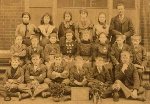   § Cable Street: 1898 - smaller, for 'only' 400
children [two early class photos right]:
built on the site of a former sugar refinery, it bears a plaque 'Cable Street Schools' but has had various names and uses in its time, as maps
of the area bear witness. (Some show it as
'Nathaniel Heckford School': Nathaniel Heckford
was a paediatrician who founded the East London Hospital for Children,
near what is now Heckford Street further along The Highway). § Cable Street: 1898 - smaller, for 'only' 400
children [two early class photos right]:
built on the site of a former sugar refinery, it bears a plaque 'Cable Street Schools' but has had various names and uses in its time, as maps
of the area bear witness. (Some show it as
'Nathaniel Heckford School': Nathaniel Heckford
was a paediatrician who founded the East London Hospital for Children,
near what is now Heckford Street further along The Highway).
These 1908 photographs show: boys' drill, girls' drill, netball,
special nature study, nature study, art, mixed maths and standard VII
maths.
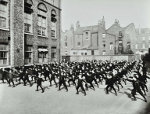 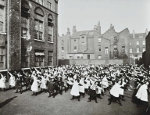 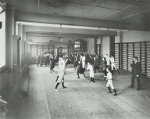 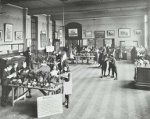 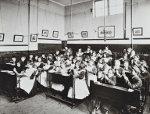 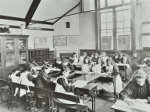 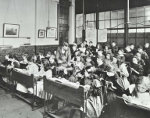 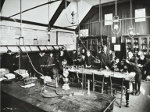
 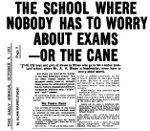 After the Second World War it became a
secondary modern school, St George-in-the-East Central School, with Alex Bloom as a pioneering headteacher from 1945-55 [left, with colleagues, possibly with colleagues from the English New Education Fellowship (later the World Education Fellowship - he is second from the left at the front]. He
rejected regimentation, corporal punishment, and the use of
marks, prizes and competition, and introduced a school council which
among other things voted for lunchtime ballroom dancing, and the
selling of cakes from a local bakery in the school canteen. Right is a 1951 article from the Daily Mirror about his work. After the Second World War it became a
secondary modern school, St George-in-the-East Central School, with Alex Bloom as a pioneering headteacher from 1945-55 [left, with colleagues, possibly with colleagues from the English New Education Fellowship (later the World Education Fellowship - he is second from the left at the front]. He
rejected regimentation, corporal punishment, and the use of
marks, prizes and competition, and introduced a school council which
among other things voted for lunchtime ballroom dancing, and the
selling of cakes from a local bakery in the school canteen. Right is a 1951 article from the Daily Mirror about his work.
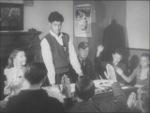 Left is Abraham Wilson, addressing the school council (a still from a film made by the Rank Organisation about post-war developments in English education): a Ghanaian (who had previously attended St Paul Whitechapel and other local primaries - and is now a member of the Bahá'í faith)
whose fascinating website recalls the Bloom era: assemblies with
classical music, and his stress on keeping down noise in the school (keep your foot on the soft pedal). Left is Abraham Wilson, addressing the school council (a still from a film made by the Rank Organisation about post-war developments in English education): a Ghanaian (who had previously attended St Paul Whitechapel and other local primaries - and is now a member of the Bahá'í faith)
whose fascinating website recalls the Bloom era: assemblies with
classical music, and his stress on keeping down noise in the school (keep your foot on the soft pedal).
 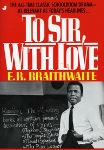 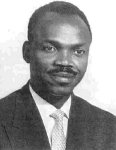 It was in Bloom's time that Edward Ricardo
Braithwaite, the Guyanan author of To
Sir with Love,
taught here. He was
an engineer who served as an RAF bomber pilot in the Second World War,
but struggled to find employment because he was black, and so trained
as a teacher. (The well-known film, starring Sidney Poitier,
with Lulu, Judy Geeson, Suzy Kendall, Adrienne Posta, Patricia
Routledge and other rising stars) was made elsewhere; Braithwaite later
said of if I loathe that film from the bottom of my heart, because
it focused on the classroom rather than on the wider issues of black
recognition.) He revisted the area in 2007, for the first time in many
years, for a Radio 4 programme. He walked round St George's and read
out the sign for the crypt hall, and then tried to peep into the crypt.
His 1965 novel Choice of Straws was
adapted for Radio 4 in 2009. He was present at the 2013 Northampton
premiere of Ayub Khan-Din's well-reviewed play based on his autobiography, with Ansu
Kabia as the Braithwaite character 'Ricky' [far right] and Matthew Kelly as the
headteacher 'Florian'. He died in 201, aged 104 - see the Guardian obituary. It was in Bloom's time that Edward Ricardo
Braithwaite, the Guyanan author of To
Sir with Love,
taught here. He was
an engineer who served as an RAF bomber pilot in the Second World War,
but struggled to find employment because he was black, and so trained
as a teacher. (The well-known film, starring Sidney Poitier,
with Lulu, Judy Geeson, Suzy Kendall, Adrienne Posta, Patricia
Routledge and other rising stars) was made elsewhere; Braithwaite later
said of if I loathe that film from the bottom of my heart, because
it focused on the classroom rather than on the wider issues of black
recognition.) He revisted the area in 2007, for the first time in many
years, for a Radio 4 programme. He walked round St George's and read
out the sign for the crypt hall, and then tried to peep into the crypt.
His 1965 novel Choice of Straws was
adapted for Radio 4 in 2009. He was present at the 2013 Northampton
premiere of Ayub Khan-Din's well-reviewed play based on his autobiography, with Ansu
Kabia as the Braithwaite character 'Ricky' [far right] and Matthew Kelly as the
headteacher 'Florian'. He died in 201, aged 104 - see the Guardian obituary.
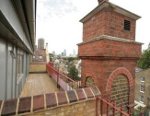 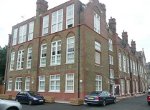 The building subsequently provided accommodation for various local schools being rebuilt, and has now been
converted into 34 luxury apartments as 'Mulberry House' [right]. Though
Mulberry Girls' School was only one of various temporary occupants, the
mulberry tree with its connection with silk weaving is locally
significant! The building subsequently provided accommodation for various local schools being rebuilt, and has now been
converted into 34 luxury apartments as 'Mulberry House' [right]. Though
Mulberry Girls' School was only one of various temporary occupants, the
mulberry tree with its connection with silk weaving is locally
significant!
|
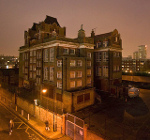 Christian Street: 1901
- built on the site of Martineau's sugar refinery, which at one time had
the tallest chimney in London; it was the first
local school to have a Jewish headteacher, Isaac Goldstone in 1908.
Professor Bill Fishman (b.1921) was a pupil here - here
are his childhood memories of the area. Under postwar legislation, it
was transferred to denominational control as Bishop Challoner Girls
Secondary School, which is now part of Bishop Challoner Catholic Collegiate School and Learning Village off Commercial Road; the Christian Street site [right by night before demolition] has been redeveloped for housing by Bellway Homes as SpacE1. Its former London School Board monogram is now laid flat in the small grassed area at the end of Ponler Street. Christian Street: 1901
- built on the site of Martineau's sugar refinery, which at one time had
the tallest chimney in London; it was the first
local school to have a Jewish headteacher, Isaac Goldstone in 1908.
Professor Bill Fishman (b.1921) was a pupil here - here
are his childhood memories of the area. Under postwar legislation, it
was transferred to denominational control as Bishop Challoner Girls
Secondary School, which is now part of Bishop Challoner Catholic Collegiate School and Learning Village off Commercial Road; the Christian Street site [right by night before demolition] has been redeveloped for housing by Bellway Homes as SpacE1. Its former London School Board monogram is now laid flat in the small grassed area at the end of Ponler Street.
|
 St George's Street,
The
Highway (off Dellow [formerly Victoria] Street), shown right on
Goad's 1887 insurance map - with two other schools
beyond: regarded as a school of 'special difficulty'. Its
headteacher in 1898 was J. Mellows. See here for a spat over evening dancing classes, and here for classes in Esperanto. Mrs Louisa Hopkins, for the report noted above, also visited this school, and commented briefly: St George's Street,
The
Highway (off Dellow [formerly Victoria] Street), shown right on
Goad's 1887 insurance map - with two other schools
beyond: regarded as a school of 'special difficulty'. Its
headteacher in 1898 was J. Mellows. See here for a spat over evening dancing classes, and here for classes in Esperanto. Mrs Louisa Hopkins, for the report noted above, also visited this school, and commented briefly:
We went to the Highway School for girls, close to the scene of the worst White Chapel murders [does she mean 1888 Ripper victim Elizabeth Stride, linked to the nearby Swedish church and brought to the mortunary in the churchyard but killed some distance away, or the Marr murders of 1811?]
It is a fine new building, about five years old. The care-taker lives
in a house on the premises, and opens the gate to visitors; he had a
beautiful show of potted plants in bloom, with pretty shells near the
opening of the yard. All the girls were out at play, the mistresses
with them.
|
This is the more likely location for Dicken's opium den in Edwin Drood - note the comment from 1897 that the
particular den described in the story was pulled down some years ago to
make room for a Board-school playground, while the bedstead, pipes,
etc., were purchased by Americans and others interested in curious
relics.
|
§ These
schools came to cater for those classified as 'M.D.' (mentally
defective), which together with those for the partially deaf formed the
'St George's-in-the-East Group' (and from 1908 'Stepney (No.2) Group of
Special Schools').
|


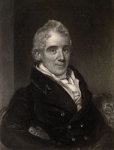 In 1811 the National Society
was
founded, with the aim of establishing a church school in every
parish, and training and paying teachers for them. One of its founders
was Joshua Watson, brother of the Rector of Hackney, who retired at the
age of 43 having made a fortune in the wine trade and devoted the rest
of his life to this cause. The original name was 'The National Society
for the Promotion of
the Education of the Poor in the Principles of the Established
Church': its schools taught basic skills, and provided for moral and
spiritual welfare by teaching the 'national religion', in its Anglican
form. The founders' concern for the children of the
newly-industrialised cities was both philanthropic and motivated by anxiety about
social order. Astonishingly, by 1851 (anticipating state provision by
20 years) they had established 12,000 schools in England and Wales. The
National Society continues its work - our parish's honorary assistant
priest and Rector's wife, Jan Ainsworth, is its General Secretary and
Chief Education Officer of the Church of England - and celebrated its
bicentenary in 2011: see Lois Louden Distinctive and Inclusive: The National Society and Church of England Schools 1811-2011 (National Society 2012).
In our parish, the schools of St George-in-the-East (Cannon Street Road), Christ Church Watney Street, St Mark
Whitechapel, St Mary Johnson Street and St Paul Dock Street all
benefitted from its support
and funding - all but the last now gone.
In 1811 the National Society
was
founded, with the aim of establishing a church school in every
parish, and training and paying teachers for them. One of its founders
was Joshua Watson, brother of the Rector of Hackney, who retired at the
age of 43 having made a fortune in the wine trade and devoted the rest
of his life to this cause. The original name was 'The National Society
for the Promotion of
the Education of the Poor in the Principles of the Established
Church': its schools taught basic skills, and provided for moral and
spiritual welfare by teaching the 'national religion', in its Anglican
form. The founders' concern for the children of the
newly-industrialised cities was both philanthropic and motivated by anxiety about
social order. Astonishingly, by 1851 (anticipating state provision by
20 years) they had established 12,000 schools in England and Wales. The
National Society continues its work - our parish's honorary assistant
priest and Rector's wife, Jan Ainsworth, is its General Secretary and
Chief Education Officer of the Church of England - and celebrated its
bicentenary in 2011: see Lois Louden Distinctive and Inclusive: The National Society and Church of England Schools 1811-2011 (National Society 2012).
In our parish, the schools of St George-in-the-East (Cannon Street Road), Christ Church Watney Street, St Mark
Whitechapel, St Mary Johnson Street and St Paul Dock Street all
benefitted from its support
and funding - all but the last now gone.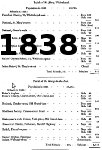 A shorter list of 1838, from the Minutes of the Select Committee on Education of the Poorer Classes [right] gives numbers:
A shorter list of 1838, from the Minutes of the Select Committee on Education of the Poorer Classes [right] gives numbers:  Dissenters' Charity,
Pell-street, Ratcliff-highway - 50 boys: was this the 'Tower Hamlets School' mentioned in
1815? The list of Subscription Charities & Public Societies in London
(John Murray 1823) refers to the 'Tower Hamlets Society for Clothing
and Educating Poor Children in the Protestant Religion' for which two
sermons had been preached the previous year at the parish church of St
John Wapping, though many of its benefactors were
non-Anglicans: for example, in 1810 £50 from Andrew Knies, a sugar baker of Wellclose Square (who also left money
to the German Reformed Church in the Savoy and to Robert Stodhart's chapel in
Pell Street, as well as to the Middlesex Society); in 1828 Henry Mum,
probably a member of
Zion Chapel, Whitechapel, made various educational bequests including
£100 of 3% bank annuities to the school; and in 1829 Johann George
Wicke, a member of the German chapel in Hooper Square,
left £50 to the school 'of which he is a member'. As the 1868 map [right] shows, there was a schoolhouse, marked as 'Pell Street Charity School', next to Stodhart's chapel, though according to him it was run by G.C. Smith's organisation, for 300 seamen's children.
Dissenters' Charity,
Pell-street, Ratcliff-highway - 50 boys: was this the 'Tower Hamlets School' mentioned in
1815? The list of Subscription Charities & Public Societies in London
(John Murray 1823) refers to the 'Tower Hamlets Society for Clothing
and Educating Poor Children in the Protestant Religion' for which two
sermons had been preached the previous year at the parish church of St
John Wapping, though many of its benefactors were
non-Anglicans: for example, in 1810 £50 from Andrew Knies, a sugar baker of Wellclose Square (who also left money
to the German Reformed Church in the Savoy and to Robert Stodhart's chapel in
Pell Street, as well as to the Middlesex Society); in 1828 Henry Mum,
probably a member of
Zion Chapel, Whitechapel, made various educational bequests including
£100 of 3% bank annuities to the school; and in 1829 Johann George
Wicke, a member of the German chapel in Hooper Square,
left £50 to the school 'of which he is a member'. As the 1868 map [right] shows, there was a schoolhouse, marked as 'Pell Street Charity School', next to Stodhart's chapel, though according to him it was run by G.C. Smith's organisation, for 300 seamen's children. 

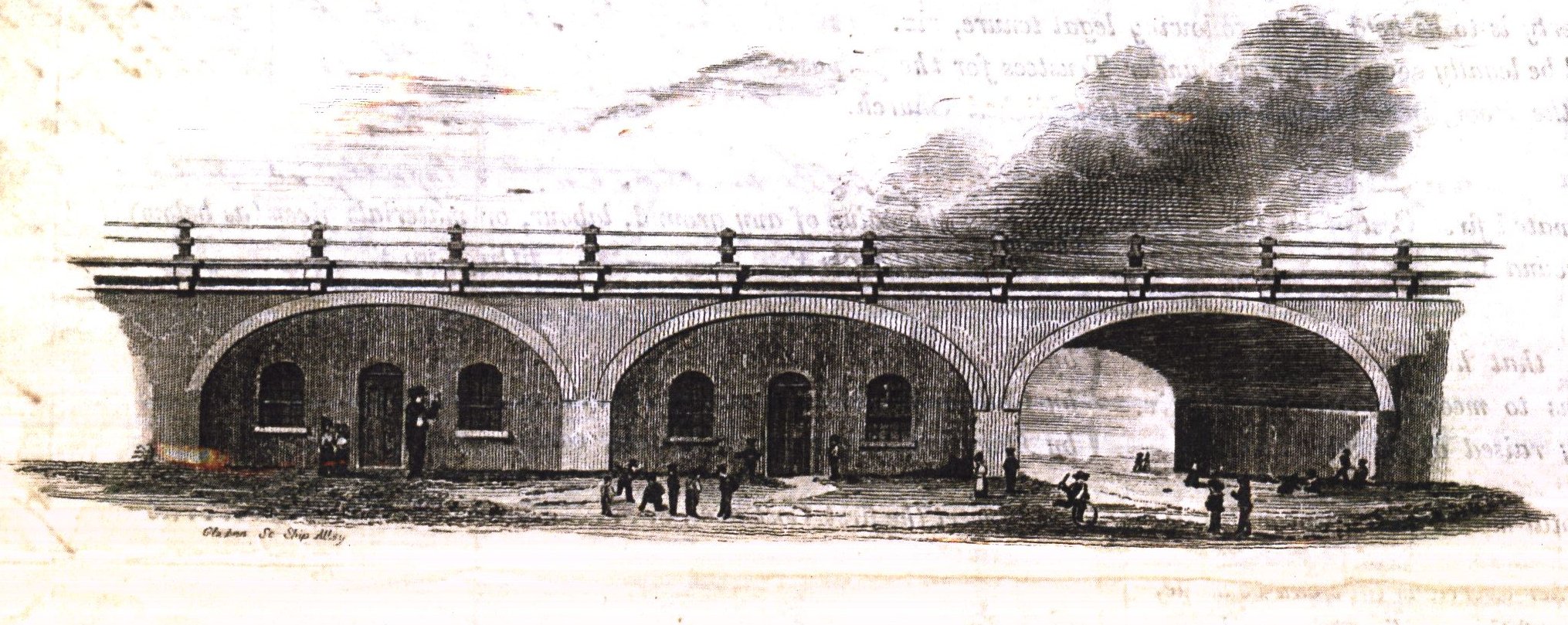 The
first major project of William Quekett, the energetic
curate of St George-in-the-East from 1830 and first incumbent of Christ
Church Watney Street, was to fit out as boys,
girls and infants schools three arches
east of Cannon Street Road, near Walburgh Street, under the
viaduct of the new London
and Blackwall Railway, which he persuaded the directors to
let on a 100-year lease for
£20
a year, reasoning that as the trains were cable-hauled from stationary
steam engines there would be no engine noise! In the event, this
system failed and conventional engines were used - see here for more details. The
drawing is from the
National
Society's archive in Bermondsey. The handwritten note says There is communication with each arch by a
door in the centre - and to warmed [sic] by an Arnotts' Stove. The 1878 Vestry map shows the location; they are shown as 'Christ Church School' on this 1868 map. [See below for the later fate of these premises.]
The
first major project of William Quekett, the energetic
curate of St George-in-the-East from 1830 and first incumbent of Christ
Church Watney Street, was to fit out as boys,
girls and infants schools three arches
east of Cannon Street Road, near Walburgh Street, under the
viaduct of the new London
and Blackwall Railway, which he persuaded the directors to
let on a 100-year lease for
£20
a year, reasoning that as the trains were cable-hauled from stationary
steam engines there would be no engine noise! In the event, this
system failed and conventional engines were used - see here for more details. The
drawing is from the
National
Society's archive in Bermondsey. The handwritten note says There is communication with each arch by a
door in the centre - and to warmed [sic] by an Arnotts' Stove. The 1878 Vestry map shows the location; they are shown as 'Christ Church School' on this 1868 map. [See below for the later fate of these premises.] 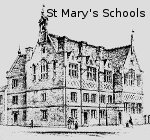 William Quekett
went on to identify a site for new schools in the eastern end of the
parish, which was to become the parish of St Mary Johnson Street. St Mary's Schools were designed by George Smith and begun in 1848, providing places for a
further 550 children. Quekett claimed he
never remembered any child from 'his' schools being in prison. When
asked Supposing a child who had
been in prison applied to one of your schools, would you admit
him? he replied Certainly
not.
William Quekett
went on to identify a site for new schools in the eastern end of the
parish, which was to become the parish of St Mary Johnson Street. St Mary's Schools were designed by George Smith and begun in 1848, providing places for a
further 550 children. Quekett claimed he
never remembered any child from 'his' schools being in prison. When
asked Supposing a child who had
been in prison applied to one of your schools, would you admit
him? he replied Certainly
not. In the newly-created parish of St Mark Whitechapel
National Schools were
established in 1841 with a schoolroom between Chamber Street and Royal
Mint Street, initially in a portion of a house and two arches under the Blackwall Railway. J. Gledhill, from Battersea Training College, was appointed the master in 1857. The boys' section was rebuilt in 1862, to
designs by John Hudson of 40 Leman Street (for which Mr John Jacobs
submitted a tender for £685 with £360 for extra classrooms, and Mr F.F.
Dudley £675 with £325 for the classrooms).
The site is shown left from
Goad's 1887 insurance maps, demonstrating how it had become hemmed in
by railway lines. From 1912 to 1921 the school was in protracted
negotiation with the
Midland Railway over windows opening onto railway property; draft
agreements were eventually produced. In the latter year a petition for
closure of the school was submitted, but this did not happen; the final
report by the LCC inspectors was in 1939, and it presumably closed
during the war. A member of our congregation remembers attending the
school. (The London Metropolitan Archives hold a series of files on
church and school matters.)
In the newly-created parish of St Mark Whitechapel
National Schools were
established in 1841 with a schoolroom between Chamber Street and Royal
Mint Street, initially in a portion of a house and two arches under the Blackwall Railway. J. Gledhill, from Battersea Training College, was appointed the master in 1857. The boys' section was rebuilt in 1862, to
designs by John Hudson of 40 Leman Street (for which Mr John Jacobs
submitted a tender for £685 with £360 for extra classrooms, and Mr F.F.
Dudley £675 with £325 for the classrooms).
The site is shown left from
Goad's 1887 insurance maps, demonstrating how it had become hemmed in
by railway lines. From 1912 to 1921 the school was in protracted
negotiation with the
Midland Railway over windows opening onto railway property; draft
agreements were eventually produced. In the latter year a petition for
closure of the school was submitted, but this did not happen; the final
report by the LCC inspectors was in 1939, and it presumably closed
during the war. A member of our congregation remembers attending the
school. (The London Metropolitan Archives hold a series of files on
church and school matters.)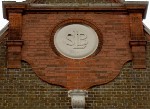 This Commission paved the way - at last - for significant state provision and funding. Major change came with the 1870
Education Act,
which created local School Boards, elected by ratepayers:
significantly, women were
eligible, and a number were elected in London. Under the 1870 and 1873 Acts (continued under the 1885 School Boards Act), the London School Board had 55 members, elected triennially, five of them from Tower Hamlets (with Thomas G. Harrison, vestry clerk of St George-in-the-East, as returning officer. Boards were
empowered to build
elementary schools (5-12 years) 'on the rates' - a member of St
George's Vestry protested in 1876 at the level of expenditure. Parents
still paid fees - unless they were very poor. Religious education was
on a 'non-denominational' basis (the result of the then-controversial
'Cowper-Temple clause'): see this
1869 conference paper by the Revd R.E. Bartlett, previously of St Mark
Whitechapel, on the subject. Boards could also provide subsidies to
church
schools. Left is
the London School Board monogram, which appeared on all its schools.
Many of the clergy from the churches of our parish were to serve on the
Board.
This Commission paved the way - at last - for significant state provision and funding. Major change came with the 1870
Education Act,
which created local School Boards, elected by ratepayers:
significantly, women were
eligible, and a number were elected in London. Under the 1870 and 1873 Acts (continued under the 1885 School Boards Act), the London School Board had 55 members, elected triennially, five of them from Tower Hamlets (with Thomas G. Harrison, vestry clerk of St George-in-the-East, as returning officer. Boards were
empowered to build
elementary schools (5-12 years) 'on the rates' - a member of St
George's Vestry protested in 1876 at the level of expenditure. Parents
still paid fees - unless they were very poor. Religious education was
on a 'non-denominational' basis (the result of the then-controversial
'Cowper-Temple clause'): see this
1869 conference paper by the Revd R.E. Bartlett, previously of St Mark
Whitechapel, on the subject. Boards could also provide subsidies to
church
schools. Left is
the London School Board monogram, which appeared on all its schools.
Many of the clergy from the churches of our parish were to serve on the
Board.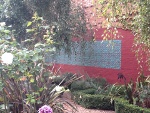 Some of the clergy supported this
programme (in particular, Harry Jones,
Rector of St George-in-the-East from 1873); others did not, because it
reduced their influence. At Christ Church Watney Street, for instance,
the loss of the
railway arches schools
was a major blow - see its Rector's comments below. Its three arches are now the site of James Garden, a small community garden [right]
created and lovingly maintained by the St George's Gardens association
and other local residents in memory of James Gair. The church also
lost the attendance of the Middlesex Society scholars when, in
consequence of the Act, this School was incorporated into Raine's
Foundation - see above for both institutions - though, as explained here, as part of the
scheme £600 was provided to build a mission room adjacent to the church. See this
1875 analysis by Canon Robert Gregory, Treasurer of the National
Society and member of the London School Board, of the relative cost of
voluntary and national schools.
Some of the clergy supported this
programme (in particular, Harry Jones,
Rector of St George-in-the-East from 1873); others did not, because it
reduced their influence. At Christ Church Watney Street, for instance,
the loss of the
railway arches schools
was a major blow - see its Rector's comments below. Its three arches are now the site of James Garden, a small community garden [right]
created and lovingly maintained by the St George's Gardens association
and other local residents in memory of James Gair. The church also
lost the attendance of the Middlesex Society scholars when, in
consequence of the Act, this School was incorporated into Raine's
Foundation - see above for both institutions - though, as explained here, as part of the
scheme £600 was provided to build a mission room adjacent to the church. See this
1875 analysis by Canon Robert Gregory, Treasurer of the National
Society and member of the London School Board, of the relative cost of
voluntary and national schools. § Berner Street: 1871, disused by the 1920s; now the site of Bernhard Baron House
[street renamed Henriques Street 1961] - Harry Gosling School was built opposite in 1909 - the site of both schools is shown on Goad's 1899 insurance map, right. Here
is a paper on 'Scientific Method in Board Schools' delivered in the
school in 1895. In July 1892 Mrs Louisa Hopkins, chair of a Massachusetts commission
appointed to investigate manual training and industrial education,
visited this, among many other, schools. Note her comments on the
implications of being a Jewish-majority school:
§ Berner Street: 1871, disused by the 1920s; now the site of Bernhard Baron House
[street renamed Henriques Street 1961] - Harry Gosling School was built opposite in 1909 - the site of both schools is shown on Goad's 1899 insurance map, right. Here
is a paper on 'Scientific Method in Board Schools' delivered in the
school in 1895. In July 1892 Mrs Louisa Hopkins, chair of a Massachusetts commission
appointed to investigate manual training and industrial education,
visited this, among many other, schools. Note her comments on the
implications of being a Jewish-majority school:


 Lower Chapman Street [now Bigland Street] - [left on Goad's 1899 insurance map; right, from front and rear, and today]: one
of Robson's earliest (built 1874-75, with additions by Bailey 1885-86), and one of the few of his to survive (with an
example of a double staircase separating boys from girls). Robson
added a cookery centre - a pioneering example of provision for
practical and vocational training. Its catchment area
included parts of Wapping, though two Board schools were also built
there. [After closure, it had a variety of uses, including the
University of Greenwich's School of Earth Sciences (as 'Walburgh
House') before becoming Darul Ummah
Community Centre. The London Borough of Tower Hamlets supported their
plans for its demolition and an eight-storey replacement with three
basement levels to include a mosque, funeral facilities, a gym and a
café as well as the current boys' school. But in 2010 English Heritage,
at the instigation of the Victorian Society, listed the building (Grade
II) and revised plans are being produced.] Its listing details are as follows:
Lower Chapman Street [now Bigland Street] - [left on Goad's 1899 insurance map; right, from front and rear, and today]: one
of Robson's earliest (built 1874-75, with additions by Bailey 1885-86), and one of the few of his to survive (with an
example of a double staircase separating boys from girls). Robson
added a cookery centre - a pioneering example of provision for
practical and vocational training. Its catchment area
included parts of Wapping, though two Board schools were also built
there. [After closure, it had a variety of uses, including the
University of Greenwich's School of Earth Sciences (as 'Walburgh
House') before becoming Darul Ummah
Community Centre. The London Borough of Tower Hamlets supported their
plans for its demolition and an eight-storey replacement with three
basement levels to include a mosque, funeral facilities, a gym and a
café as well as the current boys' school. But in 2010 English Heritage,
at the instigation of the Victorian Society, listed the building (Grade
II) and revised plans are being produced.] Its listing details are as follows:

 § Cable Street: 1898 - smaller, for 'only' 400
children [two early class photos right]:
built on the site of a former sugar refinery, it bears a plaque 'Cable Street Schools' but has had various names and uses in its time, as maps
of the area bear witness. (Some show it as
'Nathaniel Heckford School': Nathaniel Heckford
was a paediatrician who founded the East London Hospital for Children,
near what is now Heckford Street further along The Highway).
§ Cable Street: 1898 - smaller, for 'only' 400
children [two early class photos right]:
built on the site of a former sugar refinery, it bears a plaque 'Cable Street Schools' but has had various names and uses in its time, as maps
of the area bear witness. (Some show it as
'Nathaniel Heckford School': Nathaniel Heckford
was a paediatrician who founded the East London Hospital for Children,
near what is now Heckford Street further along The Highway). 








 After the Second World War it became a
secondary modern school, St George-in-the-East Central School, with Alex Bloom as a pioneering headteacher from 1945-55 [left, with colleagues, possibly with colleagues from the English New Education Fellowship (later the World Education Fellowship - he is second from the left at the front]. He
rejected regimentation, corporal punishment, and the use of
marks, prizes and competition, and introduced a school council which
among other things voted for lunchtime ballroom dancing, and the
selling of cakes from a local bakery in the school canteen. Right is a 1951 article from the Daily Mirror about his work.
After the Second World War it became a
secondary modern school, St George-in-the-East Central School, with Alex Bloom as a pioneering headteacher from 1945-55 [left, with colleagues, possibly with colleagues from the English New Education Fellowship (later the World Education Fellowship - he is second from the left at the front]. He
rejected regimentation, corporal punishment, and the use of
marks, prizes and competition, and introduced a school council which
among other things voted for lunchtime ballroom dancing, and the
selling of cakes from a local bakery in the school canteen. Right is a 1951 article from the Daily Mirror about his work.  Left is Abraham Wilson, addressing the school council (a still from a film made by the Rank Organisation about post-war developments in English education): a Ghanaian (who had previously attended St Paul Whitechapel and other local primaries - and is now a member of the Bahá'í faith)
whose fascinating website recalls the Bloom era: assemblies with
classical music, and his stress on keeping down noise in the school (keep your foot on the soft pedal).
Left is Abraham Wilson, addressing the school council (a still from a film made by the Rank Organisation about post-war developments in English education): a Ghanaian (who had previously attended St Paul Whitechapel and other local primaries - and is now a member of the Bahá'í faith)
whose fascinating website recalls the Bloom era: assemblies with
classical music, and his stress on keeping down noise in the school (keep your foot on the soft pedal). 

 It was in Bloom's time that Edward Ricardo
Braithwaite, the Guyanan author of To
Sir with Love,
taught here. He was
an engineer who served as an RAF bomber pilot in the Second World War,
but struggled to find employment because he was black, and so trained
as a teacher. (The well-known film, starring Sidney Poitier,
with Lulu, Judy Geeson, Suzy Kendall, Adrienne Posta, Patricia
Routledge and other rising stars) was made elsewhere; Braithwaite later
said of if I loathe that film from the bottom of my heart, because
it focused on the classroom rather than on the wider issues of black
recognition.) He revisted the area in 2007, for the first time in many
years, for a Radio 4 programme. He walked round St George's and read
out the sign for the crypt hall, and then tried to peep into the crypt.
His 1965 novel Choice of Straws was
adapted for Radio 4 in 2009. He was present at the 2013 Northampton
premiere of Ayub Khan-Din's well-reviewed play based on his autobiography, with Ansu
Kabia as the Braithwaite character 'Ricky' [far right] and Matthew Kelly as the
headteacher 'Florian'. He died in 201, aged 104 - see the Guardian obituary.
It was in Bloom's time that Edward Ricardo
Braithwaite, the Guyanan author of To
Sir with Love,
taught here. He was
an engineer who served as an RAF bomber pilot in the Second World War,
but struggled to find employment because he was black, and so trained
as a teacher. (The well-known film, starring Sidney Poitier,
with Lulu, Judy Geeson, Suzy Kendall, Adrienne Posta, Patricia
Routledge and other rising stars) was made elsewhere; Braithwaite later
said of if I loathe that film from the bottom of my heart, because
it focused on the classroom rather than on the wider issues of black
recognition.) He revisted the area in 2007, for the first time in many
years, for a Radio 4 programme. He walked round St George's and read
out the sign for the crypt hall, and then tried to peep into the crypt.
His 1965 novel Choice of Straws was
adapted for Radio 4 in 2009. He was present at the 2013 Northampton
premiere of Ayub Khan-Din's well-reviewed play based on his autobiography, with Ansu
Kabia as the Braithwaite character 'Ricky' [far right] and Matthew Kelly as the
headteacher 'Florian'. He died in 201, aged 104 - see the Guardian obituary. 
 The building subsequently provided accommodation for various local schools being rebuilt, and has now been
converted into 34 luxury apartments as 'Mulberry House' [right]. Though
Mulberry Girls' School was only one of various temporary occupants, the
mulberry tree with its connection with silk weaving is locally
significant!
The building subsequently provided accommodation for various local schools being rebuilt, and has now been
converted into 34 luxury apartments as 'Mulberry House' [right]. Though
Mulberry Girls' School was only one of various temporary occupants, the
mulberry tree with its connection with silk weaving is locally
significant! Christian Street: 1901
- built on the site of Martineau's sugar refinery, which at one time had
the tallest chimney in London; it was the first
local school to have a Jewish headteacher, Isaac Goldstone in 1908.
Professor Bill Fishman (b.1921) was a pupil here - here
are his childhood memories of the area. Under postwar legislation, it
was transferred to denominational control as Bishop Challoner Girls
Secondary School, which is now part of Bishop Challoner Catholic Collegiate School and Learning Village off Commercial Road; the Christian Street site [right by night before demolition] has been redeveloped for housing by Bellway Homes as SpacE1. Its former London School Board monogram is now laid flat in the small grassed area at the end of Ponler Street.
Christian Street: 1901
- built on the site of Martineau's sugar refinery, which at one time had
the tallest chimney in London; it was the first
local school to have a Jewish headteacher, Isaac Goldstone in 1908.
Professor Bill Fishman (b.1921) was a pupil here - here
are his childhood memories of the area. Under postwar legislation, it
was transferred to denominational control as Bishop Challoner Girls
Secondary School, which is now part of Bishop Challoner Catholic Collegiate School and Learning Village off Commercial Road; the Christian Street site [right by night before demolition] has been redeveloped for housing by Bellway Homes as SpacE1. Its former London School Board monogram is now laid flat in the small grassed area at the end of Ponler Street. St George's Street,
The
Highway (off Dellow [formerly Victoria] Street), shown right on
Goad's 1887 insurance map - with two other schools
beyond: regarded as a school of 'special difficulty'. Its
headteacher in 1898 was J. Mellows. See here for a spat over evening dancing classes, and here for classes in Esperanto. Mrs Louisa Hopkins, for the report noted above, also visited this school, and commented briefly:
St George's Street,
The
Highway (off Dellow [formerly Victoria] Street), shown right on
Goad's 1887 insurance map - with two other schools
beyond: regarded as a school of 'special difficulty'. Its
headteacher in 1898 was J. Mellows. See here for a spat over evening dancing classes, and here for classes in Esperanto. Mrs Louisa Hopkins, for the report noted above, also visited this school, and commented briefly: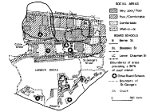 This map (from W.E. Marsden Unequal Educational Provision in East and West: The 19th Century Roots
(Psychology Press 1987) p165ff) shows how thick on the ground were the
Board Schools of the area, and how small their catchment areas, mapping
those for the first three to be built: Berner Street, Blakesley Street
and Lower Chapman Street. (It mis-locates Blakesley Street to the site
of its 1960s replacement school on Commercial Road.) The other Board
Schools above are also shown, including
Brewhouse Lane and Globe Street in Wapping. He comments The
relatively homogenous social nature of the area does not appear to have
generated a clear-cut hierarchy of elementary schools based on
differentiated fees. In 1877, for example, the two board schools then
in existence in St George's, Berner Street and Lower Chapman Street,
had fees of 1d. and 1d. or 2d. respectively. Of all the board schools
of St George's only Cable Street, small for a board school with
accommodation for 400 only, attained higher grade status. They were
conspicuous in their absence in the lists of successful London
scholarship schools.
This map (from W.E. Marsden Unequal Educational Provision in East and West: The 19th Century Roots
(Psychology Press 1987) p165ff) shows how thick on the ground were the
Board Schools of the area, and how small their catchment areas, mapping
those for the first three to be built: Berner Street, Blakesley Street
and Lower Chapman Street. (It mis-locates Blakesley Street to the site
of its 1960s replacement school on Commercial Road.) The other Board
Schools above are also shown, including
Brewhouse Lane and Globe Street in Wapping. He comments The
relatively homogenous social nature of the area does not appear to have
generated a clear-cut hierarchy of elementary schools based on
differentiated fees. In 1877, for example, the two board schools then
in existence in St George's, Berner Street and Lower Chapman Street,
had fees of 1d. and 1d. or 2d. respectively. Of all the board schools
of St George's only Cable Street, small for a board school with
accommodation for 400 only, attained higher grade status. They were
conspicuous in their absence in the lists of successful London
scholarship schools.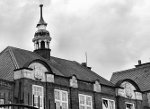
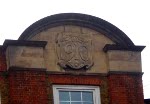
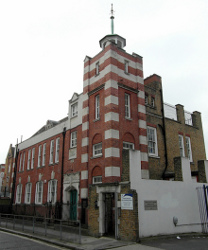
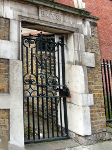
 Fairclough Street School [later renamed Harry Gosling School] as built in 1909/10. The main block was plain, but the cookery and
laundry block, designed by T.J. Bailey, is described in the current
Pevsner as charmingly detailed. Pictured left is
the school shortly after its opening, and a plaque giving the date;
Bailey's block; the boy's entrance; and the cookery and laundry doorway.
Fairclough Street School [later renamed Harry Gosling School] as built in 1909/10. The main block was plain, but the cookery and
laundry block, designed by T.J. Bailey, is described in the current
Pevsner as charmingly detailed. Pictured left is
the school shortly after its opening, and a plaque giving the date;
Bailey's block; the boy's entrance; and the cookery and laundry doorway.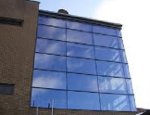
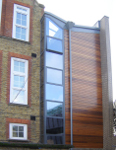
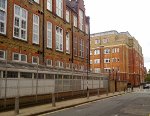
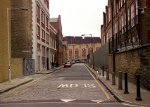 Right are two views from Fairclough Street today, and two views of the recent redevelopment and extension. To mark the school's centenary, in 2011 pupils produced an animation about its past and present. See here for more about the life of Harry Gosling. Edith Wyeth,
our long-serving warden who died in 2011, was school secretary,
occasional teacher and governor at the school for many years. The school
playground was the site of the discovery in 1888 of the body of
Elizabeth Stride, one of Jack the Ripper's victims - see here for more about her, and her Swedish connections.
Right are two views from Fairclough Street today, and two views of the recent redevelopment and extension. To mark the school's centenary, in 2011 pupils produced an animation about its past and present. See here for more about the life of Harry Gosling. Edith Wyeth,
our long-serving warden who died in 2011, was school secretary,
occasional teacher and governor at the school for many years. The school
playground was the site of the discovery in 1888 of the body of
Elizabeth Stride, one of Jack the Ripper's victims - see here for more about her, and her Swedish connections.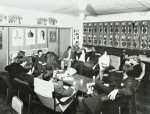
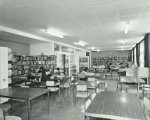
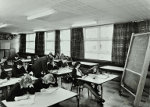

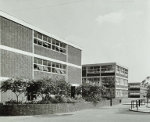
 After Blakesley Street School was demolished, a new secondary school, with an entrance on Richard Street [site left - the former 196-200 Commercial Road] was built, initially known as Tower Hamlets Secondary School [images from the 1960s right, including a lesson on binary maths, the library and staffroom], then as Tower Hamlets Secondary School for Girls (with 980 pupils, aged 11-18), and now Mulberry School for Girls, with the buildings extended and upgraded. Daphne
Gould OBE was the headteacher for seventeen years (following six as deputy)
and a member of the National Curriculum Council; she gave evidence to
the 1985 Swann Report Education for All (particularly on provision of multicultural education for girls).
After Blakesley Street School was demolished, a new secondary school, with an entrance on Richard Street [site left - the former 196-200 Commercial Road] was built, initially known as Tower Hamlets Secondary School [images from the 1960s right, including a lesson on binary maths, the library and staffroom], then as Tower Hamlets Secondary School for Girls (with 980 pupils, aged 11-18), and now Mulberry School for Girls, with the buildings extended and upgraded. Daphne
Gould OBE was the headteacher for seventeen years (following six as deputy)
and a member of the National Curriculum Council; she gave evidence to
the 1985 Swann Report Education for All (particularly on provision of multicultural education for girls).